#AWS migration
Explore tagged Tumblr posts
Text
vimeo
Explore how migrating on-premises VMware to cloud with the help of AWS migration services provider guarantees businesses robust application modernization. Read More: https://www.damcogroup.com/aws-cloud-services/aws-migration
0 notes
Text
Top 7 AWS Migration Strategies for a Seamless Cloud Transformation
0 notes
Text
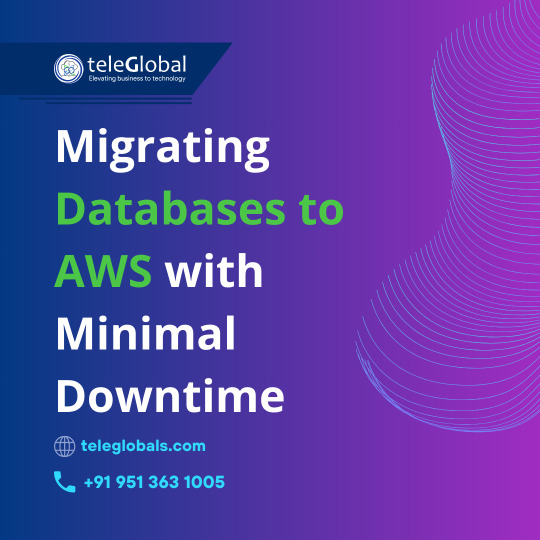
Learn to migrate databases to AWS with minimal downtime. This guide covers proven strategies, tools, and best practices to ensure a seamless, secure transition to the cloud. Optimize your AWS migration for performance and reliability with expert tips from Teleglobals. Start your journey today!
#AWS Migration#Cloud Migration#Cloud Consulting Services#Teleglobal International#cloud infrastructure
0 notes
Text
Best Practices for a Smooth Data Warehouse Migration to Amazon Redshift
In the era of big data, many organizations find themselves outgrowing traditional on-premise data warehouses. Moving to a scalable, cloud-based solution like Amazon Redshift is an attractive solution for companies looking to improve performance, cut costs, and gain flexibility in their data operations. However, data warehouse migration to AWS, particularly to Amazon Redshift, can be complex, involving careful planning and precise execution to ensure a smooth transition. In this article, we’ll explore best practices for a seamless Redshift migration, covering essential steps from planning to optimization.
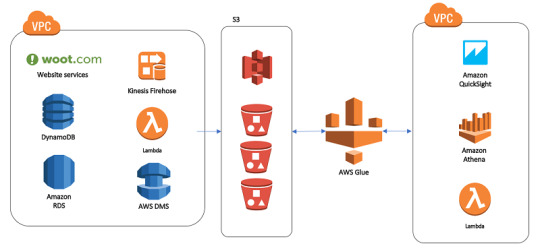
1. Establish Clear Objectives for Migration
Before diving into the technical process, it’s essential to define clear objectives for your data warehouse migration to AWS. Are you primarily looking to improve performance, reduce operational costs, or increase scalability? Understanding the ‘why’ behind your migration will help guide the entire process, from the tools you select to the migration approach.
For instance, if your main goal is to reduce costs, you’ll want to explore Amazon Redshift’s pay-as-you-go model or even Reserved Instances for predictable workloads. On the other hand, if performance is your focus, configuring the right nodes and optimizing queries will become a priority.
2. Assess and Prepare Your Data
Data assessment is a critical step in ensuring that your Redshift data warehouse can support your needs post-migration. Start by categorizing your data to determine what should be migrated and what can be archived or discarded. AWS provides tools like the AWS Schema Conversion Tool (SCT), which helps assess and convert your existing data schema for compatibility with Amazon Redshift.
For structured data that fits into Redshift’s SQL-based architecture, SCT can automatically convert schema from various sources, including Oracle and SQL Server, into a Redshift-compatible format. However, data with more complex structures might require custom ETL (Extract, Transform, Load) processes to maintain data integrity.
3. Choose the Right Migration Strategy
Amazon Redshift offers several migration strategies, each suited to different scenarios:
Lift and Shift: This approach involves migrating your data with minimal adjustments. It’s quick but may require optimization post-migration to achieve the best performance.
Re-architecting for Redshift: This strategy involves redesigning data models to leverage Redshift’s capabilities, such as columnar storage and distribution keys. Although more complex, it ensures optimal performance and scalability.
Hybrid Migration: In some cases, you may choose to keep certain workloads on-premises while migrating only specific data to Redshift. This strategy can help reduce risk and maintain critical workloads while testing Redshift’s performance.
Each strategy has its pros and cons, and selecting the best one depends on your unique business needs and resources. For a fast-tracked, low-cost migration, lift-and-shift works well, while those seeking high-performance gains should consider re-architecting.
4. Leverage Amazon’s Native Tools
Amazon Redshift provides a suite of tools that streamline and enhance the migration process:
AWS Database Migration Service (DMS): This service facilitates seamless data migration by enabling continuous data replication with minimal downtime. It’s particularly helpful for organizations that need to keep their data warehouse running during migration.
AWS Glue: Glue is a serverless data integration service that can help you prepare, transform, and load data into Redshift. It’s particularly valuable when dealing with unstructured or semi-structured data that needs to be transformed before migrating.
Using these tools allows for a smoother, more efficient migration while reducing the risk of data inconsistencies and downtime.
5. Optimize for Performance on Amazon Redshift
Once the migration is complete, it’s essential to take advantage of Redshift’s optimization features:
Use Sort and Distribution Keys: Redshift relies on distribution keys to define how data is stored across nodes. Selecting the right key can significantly improve query performance. Sort keys, on the other hand, help speed up query execution by reducing disk I/O.
Analyze and Tune Queries: Post-migration, analyze your queries to identify potential bottlenecks. Redshift’s query optimizer can help tune performance based on your specific workloads, reducing processing time for complex queries.
Compression and Encoding: Amazon Redshift offers automatic compression, reducing the size of your data and enhancing performance. Using columnar storage, Redshift efficiently compresses data, so be sure to implement optimal compression settings to save storage costs and boost query speed.
6. Plan for Security and Compliance
Data security and regulatory compliance are top priorities when migrating sensitive data to the cloud. Amazon Redshift includes various security features such as:
Data Encryption: Use encryption options, including encryption at rest using AWS Key Management Service (KMS) and encryption in transit with SSL, to protect your data during migration and beyond.
Access Control: Amazon Redshift supports AWS Identity and Access Management (IAM) roles, allowing you to define user permissions precisely, ensuring that only authorized personnel can access sensitive data.
Audit Logging: Redshift’s logging features provide transparency and traceability, allowing you to monitor all actions taken on your data warehouse. This helps meet compliance requirements and secures sensitive information.
7. Monitor and Adjust Post-Migration
Once the migration is complete, establish a monitoring routine to track the performance and health of your Redshift data warehouse. Amazon Redshift offers built-in monitoring features through Amazon CloudWatch, which can alert you to anomalies and allow for quick adjustments.
Additionally, be prepared to make adjustments as you observe user patterns and workloads. Regularly review your queries, data loads, and performance metrics, fine-tuning configurations as needed to maintain optimal performance.
Final Thoughts: Migrating to Amazon Redshift with Confidence
Migrating your data warehouse to Amazon Redshift can bring substantial advantages, but it requires careful planning, robust tools, and continuous optimization to unlock its full potential. By defining clear objectives, preparing your data, selecting the right migration strategy, and optimizing for performance, you can ensure a seamless transition to Redshift. Leveraging Amazon’s suite of tools and Redshift’s powerful features will empower your team to harness the full potential of a cloud-based data warehouse, boosting scalability, performance, and cost-efficiency.
Whether your goal is improved analytics or lower operating costs, following these best practices will help you make the most of your Amazon Redshift data warehouse, enabling your organization to thrive in a data-driven world.
#data warehouse migration to aws#redshift data warehouse#amazon redshift data warehouse#redshift migration#data warehouse to aws migration#data warehouse#aws migration
0 notes
Text
Migrating With AWS Application Migration Service
A computer sends files to cloud storage, shown through icons and digital elements illustrating data transfer, Move data to cloud storage storage With the ever-changing nature of the digital world, today’s businesses seek ways to efficiently migrate their applications to the cloud. AWS Application Migration Service (AWS MGN) comes off strong as a partner in simplifying the process with which…
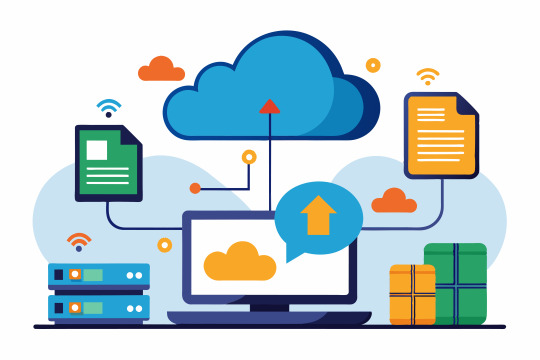
View On WordPress
0 notes
Text
An Ultimate Guide To Choosing The Right AWS Managed Hosting Partner 2024
In this blog, we delve into the pivotal role played by an AWS Managed Hosting Partner. We explore how choosing the right partner—one with seasoned expertise and tailored solutions—can unlock the full potential of AWS services. Join us as we discuss key considerations and best practices essential for selecting the ideal hosting partner to propel your cloud journey forward.
#AWS Managed Hosting Partner#AWS Managed Services Partner#AWS managed services#AWS migration#AWS services#DevOps#AWS security services#AWS Cloud Strategy#Cloud Migration Services#Cloud Security Services#Cost Optimization (AWS)
0 notes
Text
Cloud migration guide: Your strategic path to AWS migration
Today’s business world is reverberating with the drumbeat of digital transformation. Organizations across industries sprint to keep pace with evolving customer demands, competition, and ever-shifting technological landscapes.
Adopting Amazon Web Services (AWS) has become a critical catalyst for success in this high-stakes race. IT infrastructure and applications in the cloud require a well-defined AWS cloud migration strategy, one that charts the path to maximizing the transformative power of this technology.
This blog serves as your compass, guiding you through the intricacies of AWS cloud migration and empowering you to start a successful course toward digital dominance.
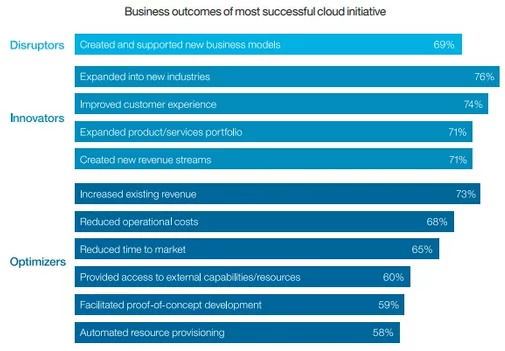
Source: IBM
Cloud migration strategies and their importance
The decision to migrate to AWS is just the first step on your digital expedition. Choosing the right path is crucial, for it affects the pace, cost, and ultimately, the success of your cloud takeover.
But why migrate at all? Why abandon the familiar confines of your on-premises castle for the uncharted territory of the cloud? Consider these treasures that beckon from the cloud:
Agility: Adapt and scale your applications quickly, just like a cloud expert avoiding digital challenges.
Scalability: If you need more servers to manage high traffic, the cloud has plenty available, just a click away.
Cost-efficiency: Ditch the expensive upkeep of on-premises infrastructure. The cloud offers a pay-as-you-go model, like renting a cloud-powered dragon instead of buying your own stable.
Innovation: Embrace the latest cloud technologies and unlock new possibilities, like using a cloud-powered telescope to scan for future business opportunities.
With these riches within reach, who wouldn’t want to join the cloud migration craze? However, navigating the landscape of the seven Rs without understanding their strengths and limitations can lead to detours and missed opportunities. In the next section, we’ll delve deeper into each R, unpacking their individual characteristics and equipping you to chart the optimal course towards your cloud kingdom.
The seven R’s of cloud migration
The seven R’s represent distinct migration strategies with varying degrees of complexity, speed, and long-term impact on your application portfolio. Let’s explore each R in detail, highlighting its purpose, suitability, and potential limitations:
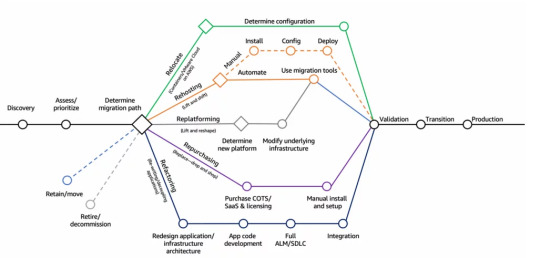
Source: AWS
1. Rehost (Lift and Shift): This rapid and cost-effective option involves directly migrating applications to the AWS cloud infrastructure without significant architectural changes. Think of it as simply relocating your servers to a cloud data center, leveraging its scalability and resilience. However, this approach may limit long-term agility and cloud-native optimization potential.
2. Relocate: If you seek specific AWS features or multi-cloud flexibility, relocating applications to a different cloud platform might be ideal. This approach requires careful planning and compatibility testing but opens doors to specialized services or cost optimization opportunities.
3. Replatform: When existing architecture impedes cloud optimization, replatforming applications allows you to fully utilize cloud-native principles. This approach involves significant reworking to unlock advanced scalability, elasticity, and resilience. However, it demands substantial resources, expertise, and planning.
4. Refactor: For applications where future-proof agility is crucial, refactoring involves building them completely from scratch, embracing serverless technologies and microservices architecture. This most comprehensive approach unlocks future potential but requires intensive resources and planning.
5. Repurchase: Instead of extensive replatforming, you can repurchase outdated applications for cost-effective cloud-native equivalents offering similar functionality. This approach streamlines maintenance, provides modern features, and leverages the inherent advantages of cloud architecture.
6. Retire: This AWS cloud migration strategy targets outdated, underutilized, or incompatible applications. Retiring these applications liberates resources and simplifies your IT infrastructure, while reducing maintenance costs and potential security vulnerabilities.
7. Retain: For stable and compliant applications, retaining them on-premises ensures operational continuity and minimizes disruption. This approach avoids unnecessary migration efforts and allows you to focus cloud resources on strategic priorities.
By understanding the strengths and limitations of each R, you can confidently choose the most appropriate migration strategy for each application in your portfolio. Remember, a hybrid approach is often optimal, tailoring specific R’s to different applications for successful cloud adoption.
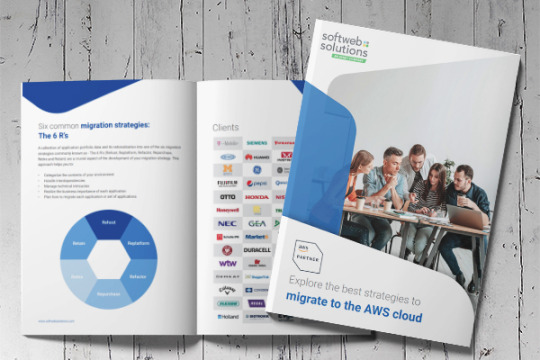
Insights
Explore the best strategies to migrate to the AWS cloud
AWS migration refers to the process of moving an organization's IT infrastructure, applications and data to the cloud-based services offered by Amazon Web Services (AWS).
Download
When to use each migration model
Migration strategy: Retire
Use Case: Outdated, underutilized, or incompatible applications
Benefits:
Simplifies infrastructure
Reduces maintenance costs
Mitigates security vulnerabilities
Implementation: Analyze workload dependencies and plan sunsetting process
Migration strategy: Retain
Use Case: Stable and compliant applications needing operational continuity
Benefits:
Minimizes disruption
Avoids unnecessary migration effort
Focuses resources on strategic priorities
Implementation: Assess compliance requirements and optimize on-premises environment
Migration strategy: Rehost (Lift & Shift)
Use Case: Rapid and cost-effective migration with minimal architectural changes
Benefits:
Leverages cloud scalability
Resilience
Reduces data center complexity
Implementation: Refine infrastructure sizing and optimize resource utilization
Migration strategy: Relocate
Use Case: Specific cloud feature requirements or multi-cloud flexibility
Benefits:
Accesses specialized services
Optimizes costs across platforms
Enhances future flexibility
Implementation: Evaluate target platform compatibility and plan data migration strategy
Migration strategy: Repurchase
Use Case: Cost-effective cloud-native alternatives for outdated applications
Benefits:
Streamlines maintenance provides modern features
Unlocks cloud-native advantages
Implementation: Identify suitable SaaS or PaaS offerings and plan application integration
Migration strategy: Replatform
Use Case: Significant performance and agility gains, but with greater reworking
Benefits:
Unlocks advanced scalability
Resilience
Future-proofs architecture
Implementation: Invest in development resources and plan application modernization roadmap
Migration strategy: Refactor
Use Case: Complete rebuild for future-proof agility and cloud-native optimization
Benefits:
Enables microservices architecture
Unlocks serverless technologies
Maximizes cloud potential
Implementation: Secure dedicated resources and prioritize development expertise
AWS migration benefits
Beyond simply transitioning your infrastructure, migrating to AWS delivers tangible benefits that empower your business to thrive in the digital landscape. These advantages stem from several key areas:
1. Unmatched agility: Adapt and respond to market shifts with lightning speed. AWS enables rapid scaling up and down of resources, effortless deployment of new applications, and real-time adjustments to meet shifting demands. This agility allows you to capitalize on fleeting opportunities and outmaneuver competitors.
2. Infinite scalability: Break free from the constraints of on-premises limitations. AWS offers boundless scalability, seamlessly accommodating spikes in activity, resource-intensive projects, and future growth. Need more servers? They’re available with a click. Require advanced analytics capabilities? Specialized services readily await. Your ambitions are no longer confined to infrastructure.
3. Optimized cost management: Ditch the burden of upfront investments and unpredictable expenses. AWS embraces a pay-as-you-go model, where you only pay for the resources you consume. This granular control enables precise cost optimization, eliminating wasted capacity and over-provisioning. Invest intelligently in cloud resources that directly drive business value.
4. Innovation as a constant: Embrace the cutting edge and propel your digital transformation. AWS constantly introduces groundbreaking services and features, opening doors to previously unimaginable possibilities. From artificial intelligence and machine learning to serverless computing and data analytics, the cloud fuels disruptive ideas and propels you ahead of the curve.
5. Global reach and resilience: Extend your digital borders and connect with customers like never before. AWS boasts a global network of data centers, ensuring exceptional performance and unparalleled redundancy regardless of your users’ location. This global reach strengthens your brand, unlocks new markets, and bolsters your disaster recovery capabilities.
6. Unwavering security and compliance: Prioritize data security and safeguard your reputation. AWS prioritizes multi-layered security controls and adheres to the highest compliance standards. Sensitive data is protected with rigorous measures, building trust with customers and minimizing risk.
Conquering cloud migration challenges
With the seven Rs as your compass, it’s time to chart your course through the inevitable challenges that arise on any AWS migration journey. By anticipating these roadblocks and proactively addressing them, you can ensure a smoother and more successful transition to the cloud. Here are some key obstacles to keep in mind:
1. Complexity and skill gap: Navigating the vast and ever-evolving AWS ecosystem can be daunting, especially for organizations with limited cloud experience. This complexity, coupled with a potential skill gap in your team, can lead to inefficient resource utilization, suboptimal architecture choices, and delayed timelines.
Strategize: Address this challenge by investing in training and certifications for your IT staff, partnering with experienced AWS consultants, and leveraging readily available online resources and documentation. Prioritize understanding core AWS services and best practices to make informed decisions throughout your migration.
2. Security considerations: Migrating sensitive data and applications to the cloud requires meticulous attention to security protocols and compliance regulations. Failure to secure your assets can lead to data breaches, reputational damage, and hefty fines.
Fortify: Implement robust access controls, data encryption, and threat detection mechanisms. Choose security-focused AWS services and adhere to industry best practices. Partnering with AWS security experts can significantly mitigate risks and ensure compliance.
3. Vendor lock-in: While leveraging the full range of AWS services can offer significant benefits, over-reliance on proprietary solutions can create an unhealthy dependence on a single vendor. This can limit your future flexibility and potentially increase costs.
Diversify: Maintain a balance between utilizing valuable AWS services and keeping some workloads on-premises or considering multi-cloud strategies. This approach enhances flexibility and bargaining power in the long run.
4. Cost management: While AWS offers flexible pricing models and optimization tools, managing cloud costs effectively requires ongoing monitoring and proactive adjustments. Uncontrolled spending can quickly eat into your budget and undermine the cost-effectiveness of your migration.
Optimize: Implement strategies like reserved instances, cost tagging, and resource auto-scaling to control expenses. Regularly review your cloud bills and identify areas for optimization. Remember, continuous cost management is the key to maximizing the financial benefits of the cloud.
Beyond migration: Embracing the digital horizon with Softweb Solutions
By embracing this roadmap, you’ll propel your business forward with agility, efficiency, and innovation. The cloud isn’t just a destination; it’s a powerful platform for growth and transformation. Don’t let questions cloud your judgment. Let Softweb Solutions be your guide to sail you through.
Originally published at https://www.softwebsolutions.com on February 14, 2024.
#AWS migration#AWS cloud migration#Cloud migration guide#AWS cloud#AWS migration benefits#AWS consultants#7 Rs Strategy
0 notes
Text
Welcome to Something Eternal: A Website Forum in 2023 wtf lmao

It's 2023, and a single belligerent rich guy destroyed one of the primary focal points of uh...global communication. Tumblr is, shockingly, kinda thriving despite the abuse it gets from its owners, but that I will call the iconic refusal of Tumblr users to let Tumblr get in the way of their using Tumblr. Reddit killed its API, removing the functionality of mobile apps that made it remotely readable (rip rif.) Discord, our current primary hangout, has made countless strange choices lately that indicate it has reached the summit of its usability and functionality, and can only decline from here as changes get made to prepare for shareholders. (NOTE: WROTE THIS POST BEFORE THEIR MOBILE "REDESIGN" LMAO)
The enshittification is intense, and it's coming from every direction. Social media platforms that felt like permanent institutions are instead slowly going to let fall fallow incredible amounts of history, works of art, thought, and fandoms. It kinda sucks!
A couple years ago, I posted about a new plan with a new domain, to focus on the archiving of media content, as I saw that to be the fatal weakness of the current ways the internet and fandoms work. Much has happened since to convince me to alter the direction of those efforts, though not abandon them entirely.
Long story short? We are launching a fucking website forum. In 2023.
If you remember In the Rose Garden, much about Something Eternal will be familiar. But this has been a year in the making, and in many ways it's far more ambitious than IRG was. We have put money on this. The forum is running on the same software major IT and technology businesses use, because I don't want the software to age out of usability within five years. It has an attached gallery system for me to post content to, including the Chiho Saito art collection. It has a profile post system that everyone already on the forum has decided is kinda like mini Twitter? But it is, fundamentally, a website forum, owned and run and moderated by us. We are not web devs. But we have run a website on pure spite and headbutting code for over twenty years, and we have over a decade of experience maintaining social spaces online, both on the OG forum, and on our Discord. Better skilled people with far more time than we have can and will build incredible alternatives to what is collapsing around us. But they're not in the room right now. We are. And you know what? Maybe it's time to return to a clunkier, slower moving, more conversation focused platform.
You're not joining a social media platform with the full polish of dozens of devs and automated moderation. Things might break, and I might need time to fix them. The emojis and such are still a work in progress. Because e-mails no longer route in reasonable normal ways, the sign-up process instead happens within the software, and has to be approved by mods. Design and structure elements may change. Etc. The point being, that the forum isn't finished, but it is at a place where I feel like I can present it to people, and it's people I need to help direct what functions and things will be in this space. You all will shape its norms, its traditions, its options...choices I could try to make now, but really...they're for us to create as a group! But the important stuff? That's there. Now let's drive this baby off the damn lot already!
Come! Join us!!
PS. As always, TERFs and Nazis need not apply.
#revolutionary girl utena#shoujo kakumei utena#rgu#sku#empty movement#utena meta#fandom stuff#fandoms#expect a somewhat spicy atmosphere#empty movement has always had deep something awful roots#and i expect the migration back to a forum will bring with it some of that more spicy attitude#also lol henry kissinger is dead god that rules
1K notes
·
View notes
Text

Does he… you know… bear off?
#how long do we wait before we add the 💅 emoji to the list#ALSO I JUST REALISED#BACKGAMMON SPOKEN ALOUD SOUNDS AN AWFUL LOT LIKE BACK COME ON#HE AND HIS… BACKGAMMON#me and who?#196#196 migration#apartmentofawesome#/r/196#r/196#rule#ruleposting#historyposting#historical shitposting#queerposting#history memes
293 notes
·
View notes
Text
nothing irritates me more than ex td fans who think they've escaped the fucking trenches and found salvation for leaving the fandom only to have moved to a newer fandom that's as popular as td was in its peak and will inevitably get a reputation as bad or even worse
#it's okay to move on from something but it's not okay to shit on people who haven't#especially if you migrate to something just as awful#lonnie talks to herself
9 notes
·
View notes
Text
4chan shutting down is so unreal, mostly because i haven’t seen a flood of noticeable new users… anywhere. it’s like the website crashed down and took everyone with it
#mine#ik a lot of them migrated to some of the similiarly awful other sites#and another portion likely had a presence on other socials anyway#but still it’s strange#it’s like the exact opposite of the reddit refugees
8 notes
·
View notes
Text
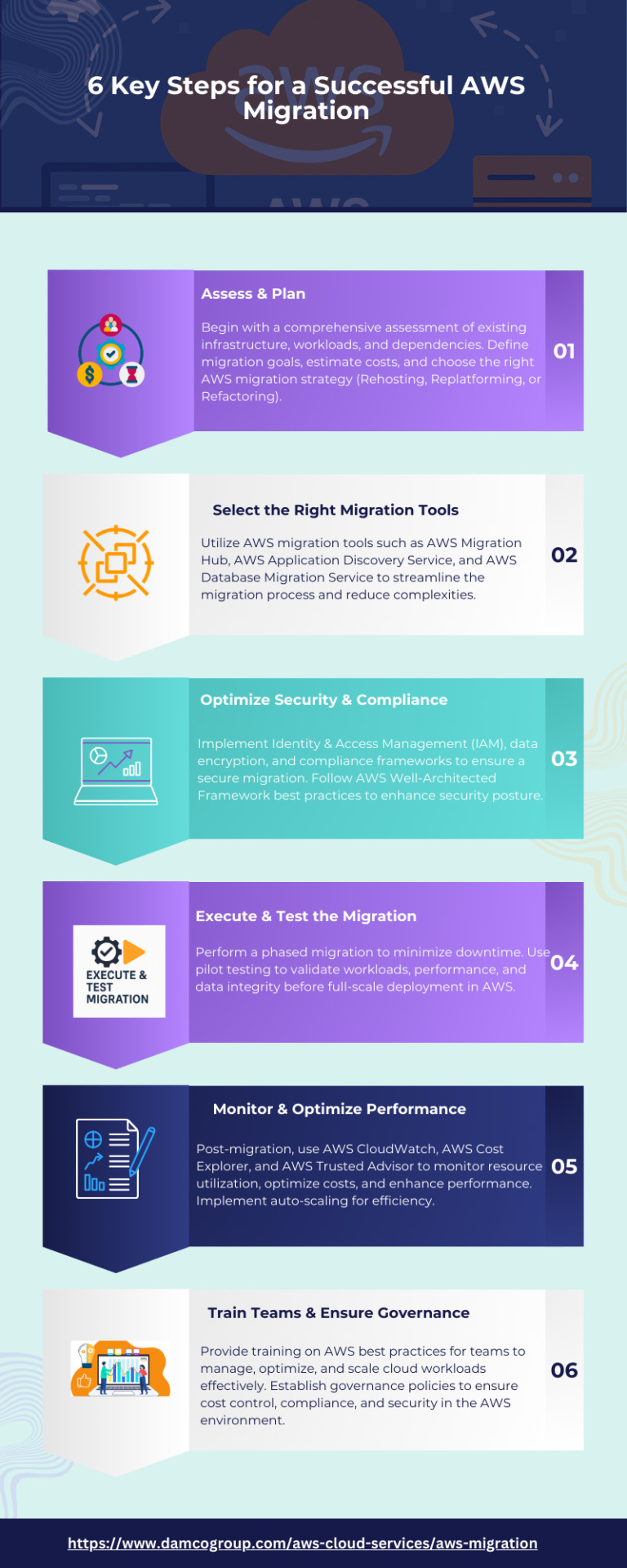
A well-planned AWS Migration strategy helps businesses enhance scalability, improve security, and optimize cloud costs. By following a structured approach using AWS tools, security measures, and performance monitoring, organizations can achieve a smooth transition while maximizing the benefits of the cloud. Read More: https://www.damcogroup.com/aws-cloud-services/aws-migration.
0 notes
Text
me realizing that I’m the tumblr middle child
#I wasn’t here when the deep magic was written but I am old enough to know the lore#I can’t say I’ve lived through every era but I can remember most of them#my blog isn’t ‘before 2014’ (at least this one isn’t) but it is before all the mass migrations#I was here before the mass migrations and watching the youngins come in#thinking ‘aw cute.. you got a lot to learn’#meanwhile there’s people on here who have years on me#g.txt
15 notes
·
View notes
Text
nothing will give me more psychic damage than waking up to a AsAm tiktoker posting repackaged antisemitism (economic scapegoatism) against another minority in a different political context! and framing it like it's some quirky asian fax!
this is like a recurring issue among AsAm/AsCan communities where they are just completely disconnected from their homelands. and i dont mean like "oh im not fluent" and not being able to access knowledge by "virtue" of language barriers. i mean politically speaking... some of the things ive seen them post PUBLICLY. FACE OUT. that they would not be comfortable saying if they were actually familiar with the socio-political context of their homelands
#pol#beans of consciousness#imagine posting about how chinese indonesians are the 5% that hoards wealth#and ofc the comments are just awful#top comment is calling chinese the jews of sea#third one was a well well well type comment that was like. curious u can say this abt the chinese. but not ANOTHER GROUP...#i truly do not appreciate anyone who resorts to economic scapegoatism under the guise of liberatory rhetoric#gee its almost like if you use the rhetoric of economic spagegoatism your target audience are antisemites sinophobes and indophobes etc etc#the way they talk about the provinces who faced the brunt of euro imperialism at the time most sea cn migrated. truly disgusting.#also saw someone being like. the chinese AND hindus in malaysia r also hoarding!!! huh. me when i have zero historical analysis
3 notes
·
View notes
Text
youtube
Yesterday's training session was a comedy of errors but I figured out some stuff!
-First, if the flirt pole is involved Tassie doesn't care who's on the other end of the leash. Buddy and I swapped back and forth and it didn't matter, Tassie wanted that cotton rope
-Second, if I'm going to do this maybe don't do it when it's insanely hot out and let my husband know NOT to play Frisbee with her twenty minutes before I'm supposed to do a highly physical training session
-Third, I forgot that Tassie has never really liked the wedge, and somehow the thought never crossed my mind that going from super-high-value flirt pole to incredibly-low-value bite wedge would be a bad fucking idea lmao
In the end the training session was NOT very productive but I'm glad I recorded it because I'm seeing a bunch of mistakes I'm making. For one, Tassie is insanely strong for her size and was absolutely dragging my buddy around no problem so I need to let her anchor herself better. I did want Tassie to drag forward a little bit to fight for that flirt pole but not quite that much. Also, when she does "win" it I am not letting her have it for long enough and that combined with the heat was a bit demotivating for her. We'll do a makeup session when it cools down later this week. Also, if I am going to work her in this kind of heat I need to hose her down beforehand, not wait until she's gasping for air.
For the bite wedge, I'm either going to have to try to figure out a way to make it more valuable for her or just use the sleeve instead. It's been long enough that I forgot she's never liked the wedge and has always half-assed bit it. She was doing full mouth bites but would immediately release either partially to breathe or entirely because she just hates holding it. Might have to see about getting a different kind of bite pillow. Also, I should have stopped the session a lot earlier instead of trying to tease her into being more invested: she just wasn't feeling it yesterday and I knew it but coordinating with other people is super difficult and I didn't want to waste my buddy's time. Next time I'll pay more attention to her body language about certain stuff. Also flirt pole last. She was fixating on that even when it WAS well out of her sight.
Oh well, learned some things and the things I fucked up aren't major! I'll have to see if next time I can do better.
#tassie#german shepherd dog#gsd#puppy stories#i debated posting this because it was such an awful session by our standards#but if im going to post the good i might as well post the bad too#not every session is a banger#its a good thing Tassie's so forgiving because i was all over the place here#on the plus side she was exhausted and content to snore the rest of the day#also the reason we keep staring at the camera was because my tripod bag was slowly migrating towards the road lol#Youtube
2 notes
·
View notes
Text
Journey to Devops
The concept of “DevOps” has been gaining traction in the IT sector for a couple of years. It involves promoting teamwork and interaction, between software developers and IT operations groups to enhance the speed and reliability of software delivery. This strategy has become widely accepted as companies strive to provide software to meet customer needs and maintain an edge, in the industry. In this article we will explore the elements of becoming a DevOps Engineer.
Step 1: Get familiar with the basics of Software Development and IT Operations:
In order to pursue a career as a DevOps Engineer it is crucial to possess a grasp of software development and IT operations. Familiarity with programming languages like Python, Java, Ruby or PHP is essential. Additionally, having knowledge about operating systems, databases and networking is vital.
Step 2: Learn the principles of DevOps:
It is crucial to comprehend and apply the principles of DevOps. Automation, continuous integration, continuous deployment and continuous monitoring are aspects that need to be understood and implemented. It is vital to learn how these principles function and how to carry them out efficiently.
Step 3: Familiarize yourself with the DevOps toolchain:
Git: Git, a distributed version control system is extensively utilized by DevOps teams, for code repository management. It aids in monitoring code alterations facilitating collaboration, among team members and preserving a record of modifications made to the codebase.
Ansible: Ansible is an open source tool used for managing configurations deploying applications and automating tasks. It simplifies infrastructure management. Saves time when performing tasks.
Docker: Docker, on the other hand is a platform for containerization that allows DevOps engineers to bundle applications and dependencies into containers. This ensures consistency and compatibility across environments from development, to production.
Kubernetes: Kubernetes is an open-source container orchestration platform that helps manage and scale containers. It helps automate the deployment, scaling, and management of applications and micro-services.
Jenkins: Jenkins is an open-source automation server that helps automate the process of building, testing, and deploying software. It helps to automate repetitive tasks and improve the speed and efficiency of the software delivery process.
Nagios: Nagios is an open-source monitoring tool that helps us monitor the health and performance of our IT infrastructure. It also helps us to identify and resolve issues in real-time and ensure the high availability and reliability of IT systems as well.
Terraform: Terraform is an infrastructure as code (IAC) tool that helps manage and provision IT infrastructure. It helps us automate the process of provisioning and configuring IT resources and ensures consistency between development and production environments.
Step 4: Gain practical experience:
The best way to gain practical experience is by working on real projects and bootcamps. You can start by contributing to open-source projects or participating in coding challenges and hackathons. You can also attend workshops and online courses to improve your skills.
Step 5: Get certified:
Getting certified in DevOps can help you stand out from the crowd and showcase your expertise to various people. Some of the most popular certifications are:
Certified Kubernetes Administrator (CKA)
AWS Certified DevOps Engineer
Microsoft Certified: Azure DevOps Engineer Expert
AWS Certified Cloud Practitioner
Step 6: Build a strong professional network:
Networking is one of the most important parts of becoming a DevOps Engineer. You can join online communities, attend conferences, join webinars and connect with other professionals in the field. This will help you stay up-to-date with the latest developments and also help you find job opportunities and success.
Conclusion:
You can start your journey towards a successful career in DevOps. The most important thing is to be passionate about your work and continuously learn and improve your skills. With the right skills, experience, and network, you can achieve great success in this field and earn valuable experience.
2 notes
·
View notes